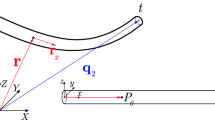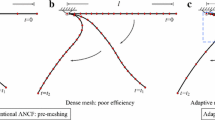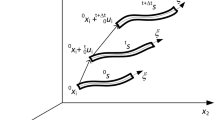Abstract
In this paper, a method for integrating the equations of motion for Absolute Nodal Coordinate Formulation cable models using the Arbitrary Lagrangian–Eulerian framework is described. The proposed semi-implicit method, based on a linearization of the generalized forces, eliminates the need for iterative solution methods required by implicit integrators and incorporates rigid holonomic constraints. Both the constraint forces and the generalized accelerations can be obtained in a single step using a linear solver greatly improving the computational efficiency. Four semi-implicit integrators are derived based on popular implicit methods. The paper examines the suitability of the four semi-implicit integrators for real-time cable simulations through three benchmark studies, comparing both the accuracy and computation speed of the method with the fully implicit Newmark method. The efficiency of the method is demonstrated by obtaining stable real-time simulations in each scenario considered.









Similar content being viewed by others
References
Moi T, Cibicik A, Rølvåg T (2020) Digital twin based condition monitoring of a knuckle boom crane: an experimental study. Eng Fail Anal 112(104):517. https://doi.org/10.1016/j.engfailanal.2020.104517
Ablow C, Schechter S (1983) Numerical simulation of undersea cable dynamics. Ocean Eng 10(6):443–457. https://doi.org/10.1016/0029-8018(83)90046-X
Winget J, Huston R (1976) Cable dynamics—a finite segment approach. Comput Struct 6(6):475–480. https://doi.org/10.1016/0045-7949(76)90042-0
Buckham B, Driscoll FR, Nahon M (2004) Development of a finite element cable model for use in low-tension dynamics simulation. J Appl Mech 71(4):476–485. https://doi.org/10.1115/1.1755691
Shabana AA (1997) Flexible multibody dynamics: review of past and recent developments. Multibody SysDyn 1(2):189–222. https://doi.org/10.1023/A:1009773505418
Westin C (2018) Modelling and simulation of marine cables with dynamic winch and sheave contact. Master’s thesis, Carleton University. https://doi.org/10.22215/etd/2018-13246
Westin C, Irani RA (2021) Modeling dynamic cable-sheave contact and detachment during towing operations. Mar Struct 77(102):960. https://doi.org/10.1016/j.marstruc.2021.102960
Lugrís U, Escalona J, Dopico D et al (2011) Efficient and accurate simulation of the rope-sheave interaction in weight-lifting machines. Proc Inst Mech Eng Part K J Multi-body Dyn 225(4):331–343. https://doi.org/10.1177/1464419311403224
Westin C, Irani RA (2017) Cable-pulley interaction with dynamic wrap angle using the absolute nodal coordinate formulation. In: Proceedings of the 4th International conference of control, dynamic systems, and robotics. https://doi.org/10.11159/cdsr17.133
Bulin R, Hajžman M, Polach P (2017) Nonlinear dynamics of a cable-pulley system using the absolute nodal coordinate formulation. Mech Res Commun 82:21–28. https://doi.org/10.1016/j.mechrescom.2017.01.001
Sheng F, Zhong Z, Wang KH (2020) Theory and model implementation for analyzing line structures subject to dynamic motions of large deformation and elongation using the absolute nodal coordinate formulation (ANCF) approach. Nonlinear Dyn 101(1):333–359. https://doi.org/10.1007/s11071-020-05783-4
Hong D, Tang J, Ren G (2011) Dynamic modeling of mass-flowing linear medium with large amplitude displacement and rotation. J Fluids Struct 27(8):1137–1148. https://doi.org/10.1016/j.jfluidstructs.2011.06.006
Fotland G, Haskins C, Rølvåg T (2020) Trade study to select best alternative for cable and pulley simulation for cranes on offshore vessels. Syst Eng 23(2):177–188. https://doi.org/10.1002/sys.21503
Escalona JL (2017) An arbitrary Lagrangian–Eulerian discretization method for modeling and simulation of reeving systems in multibody dynamics. Mech Mach Theory 112:1–21. https://doi.org/10.1016/j.mechmachtheory.2017.01.014
Tang J, Ren G, Zhu W et al (2011) Dynamics of variable-length tethers with application to tethered satellite deployment. Commun Nonlinear Sci Numer Simul 16(8):3411–3424. https://doi.org/10.1016/j.cnsns.2010.11.026
Sun J, Tian Q, Hu H et al (2018) Topology optimization of a flexible multibody system with variable-length bodies described by ALE-ANCF. Nonlinear Dyn 93(2):413–441. https://doi.org/10.1007/s11071-018-4201-6
De Jalon JG, Bayo E (2012) Kinematic and dynamic simulation of multibody systems: the real-time challenge. Springer, New York
Fotland G, Haugen B (2022) Numerical integration algorithms and constraint formulations for an ALE-ANCF cable element. Mech Mach Theory 170(104):659. https://doi.org/10.1016/j.mechmachtheory.2021.104659
Baraff D, Witkin A (1998) Large steps in cloth simulation. In: Proceedings of the 25th Annual conference on computer graphics and interactive techniques, pp 43–54. https://doi.org/10.1145/280814.280821
Choi KJ, Ko HS (2002) Stable but responsive cloth. ACM Trans Graph 21(3):604–611. https://doi.org/10.1145/566654.566624
Sugiyama H, Shabana AA (2004) On the use of implicit integration methods and the absolute nodal coordinate formulation in the analysis of elasto-plastic deformation problems. Nonlinear Dyn 37(3):245–270. https://doi.org/10.1023/B:NODY.0000044644.53684.5b
Hewlett J, Arbatani S, Kövecses J (2020) A fast and stable first-order method for simulation of flexible beams and cables. Nonlinear Dyn 99(2):1211–1226. https://doi.org/10.1007/s11071-019-05347-1
Servin M, Lacoursiere C, Melin N (2006) Interactive simulation of elastic deformable materials. In: SIGRAD 2006. The Annual SIGRAD conference; special theme: computer games, 019
Baumgarte J (1972) Stabilization of constraints and integrals of motion in dynamical systems. Comput Methods Appl Mech Eng 1(1):1–16. https://doi.org/10.1016/0045-7825(72)90018-7
Negrut D, Rampalli R, Ottarsson G et al (2005) On the use of the HHT method in the context of index 3 differential algebraic equations of multibody dynamics. In: International design engineering technical conferences and computers and information in engineering conference, pp 207–218. https://doi.org/10.1115/DETC2005-85096
Takehara S, Terumichi Y, Sogabe K (2011) Motion of a submerged tether subject to large deformations and displacements. J Syst Des Dyn 5(2):296–305. https://doi.org/10.1299/jsdd.5.296
Acknowledgements
The authors acknowledge the support of the Natural Sciences and Engineering Research Council of Canada (NSERC) and the Ontario Graduate Scholarship (OGS).
Funding
Funding for this research was provided by the Natural Sciences and Engineering Research Council of Canada (NSERC), reference numbers RGPIN-2017-06967 and RGPIN-2022-04934.
Author information
Authors and Affiliations
Contributions
Both authors contributed to the study conception and design. Coding, analysis and writing of the manuscript was performed by Cassidy Westin. Both authors commented on previous drafts and approved the final manuscript.
Corresponding author
Ethics declarations
Conflict of interests
The authors declare that there are no conflicts of interest in relation to this article.
Additional information
Publisher's Note
Springer Nature remains neutral with regard to jurisdictional claims in published maps and institutional affiliations.
Rights and permissions
Springer Nature or its licensor (e.g. a society or other partner) holds exclusive rights to this article under a publishing agreement with the author(s) or other rightsholder(s); author self-archiving of the accepted manuscript version of this article is solely governed by the terms of such publishing agreement and applicable law.
About this article
Cite this article
Westin, C., Irani, R.A. Efficient semi-implicit numerical integration of ANCF and ALE-ANCF cable models with holonomic constraints. Comput Mech 71, 789–800 (2023). https://doi.org/10.1007/s00466-022-02264-w
Received:
Accepted:
Published:
Issue Date:
DOI: https://doi.org/10.1007/s00466-022-02264-w




